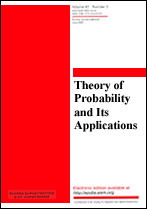|
|
Teoriya Veroyatnostei i ee Primeneniya, 1984, Volume 29, Issue 1, Pages 65–78
(Mi tvp1959)
|
 |
|
 |
This article is cited in 3 scientific papers (total in 3 papers)
Specifications and a stopping theorem for random fields
S. E. Kuznecov
Moscow
Abstract:
A family $\mathbf F=\{\mathscr F_t\}_{t\in\mathscr T}$ where $\mathscr T$ is a partially ordered set and $\mathscr F_t$ is a sub-$\sigma$-field of $\mathscr F$, is called a random field if $\mathscr F_s\subseteq\mathscr F_t$ whenever $s\le t$. We consider the problem of existence of compatible conditional distributions (specification) $ p_t(\omega,A)$, $A\in\mathscr F$ for a given random field $\mathbf F$.
Let $\mathscr T_0$ be a subset of $\mathscr T$ such that the set $\{t\,:\,t\in\mathscr T_0,\,t>s\}$ is countable for any $s\in\mathscr T$. The set $\mathscr T_0$ is called a skeleton of $\mathbf F$ if for each $t\in\mathscr T_0$ the $\sigma$-field $\mathscr F_t$ is countably generated and for each $t\in\mathscr T\diagdown\mathscr T_0$ one of the following conditions holds:
A. There exists a decreasing sequence $t^{(n)}\in\mathscr T_0$, $t^{(n)}\ge t$ such that $\displaystyle\mathscr F_t=\bigcap_n\mathscr F_{t^{(n)}}$.
B. There exists an increasing sequence $t_{(n)}\in\mathscr T_0$, $t_{(n)}\le t$ such that:
(i) $\displaystyle\mathscr F_t=\bigvee_n\mathscr F_{t_{(n)}}$;
(ii) if $s<t$, $s\in\mathscr T$ than $s<t_{(N)}<t$ for some $N$.
Theorem 1. Let the $\sigma$-field $\mathscr F$ be countably generated and the measure $\mathbf P$ be perfect. If the random field $\mathbf F$ has a skeleton, than it has a specification.
As examples lattice fields, generalized random fields, stochastic processes with $n$-dimensional
time etc. are considered.
Under some slightly stronger conditions we prove that for any Markov time $\tau(\omega)$
the following stopping theorem holds:
$$
\mathbf P(A\mid\mathscr F_\tau)=p_{\tau(\omega)}(\omega,A) \text{ a.\,s. }\mathbf P(A\in\mathscr F).
$$
For a Markov field we prove the existence of a Markov specification.
Received: 10.07.1981
Citation:
S. E. Kuznecov, “Specifications and a stopping theorem for random fields”, Teor. Veroyatnost. i Primenen., 29:1 (1984), 65–78; Theory Probab. Appl., 29:1 (1985), 66–78
Linking options:
https://www.mathnet.ru/eng/tvp1959 https://www.mathnet.ru/eng/tvp/v29/i1/p65
|


|




 Contact us:
Contact us: Terms of Use
Terms of Use
 Registration to the website
Registration to the website Logotypes
Logotypes








 Citation in format
Citation in format 
